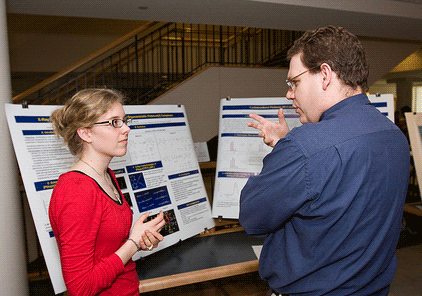Faculty Advisor
Daron E. Janzen
Department
Chemistry
Abstract
The study of organogold complexes has drawn increasing interest as practical applications of this chemistry including antitumor activity have been discovered. With this in mind, this study explores fundamentals of structure and bonding in gold(III) complexes. Specifically, cyclometallated gold(III) planar complexes were synthesized, incorporating 1,3,7-trithiacyclononane(9S3) ligands. These complexes were accessed through a scheme first involving the preparation of neutral intermediates of the form Au(N^CH)Cl3 (N^CH =2-(p-tolyl)pyridine, 2-(2’-benzothienyl)pyridine). These neutral noncyclometallated complexes were heated as neat solid complexes to induce cyclometallation. The cyclometallated complexes of the form Au(N^C)Cl2 were then reacted with 9S3 and metathesized to access the target complex salts of the form [Au(N^C)(9S3)](PF6)2. These systems were characterized by numerous methods including one- and two-dimensional nuclear magnetic resonance spectroscopy, electronic spectroscopy, thermogravimetric analysis, differential scanning calorimetry and X-ray crystallography.
Start Date
19-4-2012 11:00 AM
End Date
19-4-2012 1:00 PM
Synthesis and Structural Characterization of Cyclometallated Gold(III) Complexes
The study of organogold complexes has drawn increasing interest as practical applications of this chemistry including antitumor activity have been discovered. With this in mind, this study explores fundamentals of structure and bonding in gold(III) complexes. Specifically, cyclometallated gold(III) planar complexes were synthesized, incorporating 1,3,7-trithiacyclononane(9S3) ligands. These complexes were accessed through a scheme first involving the preparation of neutral intermediates of the form Au(N^CH)Cl3 (N^CH =2-(p-tolyl)pyridine, 2-(2’-benzothienyl)pyridine). These neutral noncyclometallated complexes were heated as neat solid complexes to induce cyclometallation. The cyclometallated complexes of the form Au(N^C)Cl2 were then reacted with 9S3 and metathesized to access the target complex salts of the form [Au(N^C)(9S3)](PF6)2. These systems were characterized by numerous methods including one- and two-dimensional nuclear magnetic resonance spectroscopy, electronic spectroscopy, thermogravimetric analysis, differential scanning calorimetry and X-ray crystallography.

